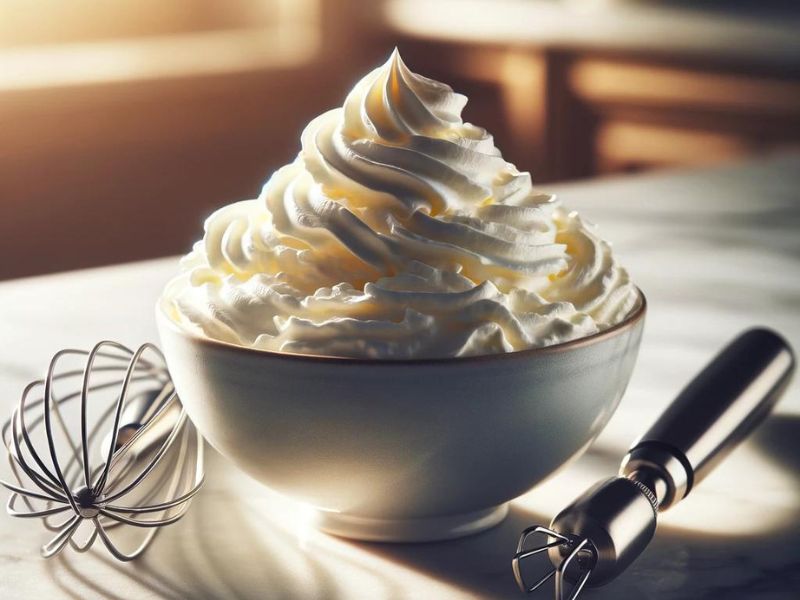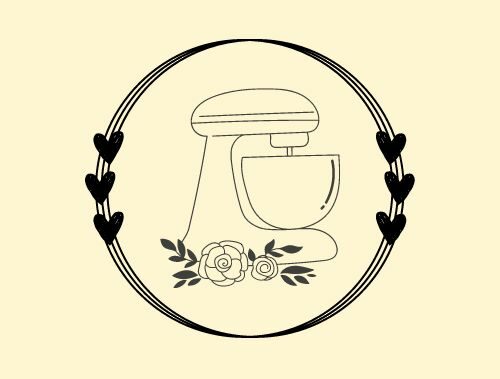Are heavy cream and heavy whipping cream the same thing? Yes, they are! This is a common question among beginner bakers, as most recipes call for “heavy cream,” but grocery stores often stock products labeled “heavy whipping cream. Some brands label their product as “heavy whipping cream” instead of just “heavy cream” to emphasize that it can be easily whipped into a stable foam for toppings and desserts.
Heavy Cream vs Heavy Whipping Cream: What’s the Difference?
When I first began to bake, this very thing confused me. My recipe called for heavy cream, but when I went to the store, all I could find was heavy whipping cream. I didn’t know that they were the same thing.
They both have at least 36% milkfat, which is more than other types of cream. This high amount of fat makes them perfect for whipping into fluffy toppings and making rich, creamy dishes. The only reason they have different names is that some brands choose to call them “heavy cream,” while others call them “heavy whipping cream.” But no matter what the label says, you can use either one in your recipes and get the same tasty results.
🍰 Cream Varieties Explained 🍦 |
||
|---|---|---|
| Type of Cream | Milk Fat Content | Common Uses |
| Light Cream | 18% – 30% | Coffee, desserts |
| Half-and-Half | 10.5% – 18% | Coffee, soups, sauces |
| Light Whipping Cream | 30% – 36% | Whipped toppings (lighter option) |
| Heavy Cream / Heavy Whipping Cream | At least 36% | Whipped toppings, sauces, ice cream, desserts |
| Brought to You by wearebaking.com | ||
Understanding Different Types of Cream
When you’re shopping for cream, you’ll notice that there are several different types available. Each one has a different amount of milk fat, which affects how it can be used in recipes.
Light cream has the lowest amount of fat, with only 18% to 30% milk fat. It’s not rich enough to whip but can be used in coffee or poured over desserts.
Half-and-half is a bit richer, with 10.5% to 18% milk fat. It’s often used in coffee and can add a creamy texture to soups and sauces, but it still can’t be whipped.
Light whipping cream is between light and heavy cream, with a milk fat content ranging from 30% to 36%. It can be whipped but may not hold its shape as well or be as stable as heavy whipping cream. Light whipping cream can be a good choice when you want a slightly lighter option or fewer calories in your recipes.
Heavy cream and heavy whipping cream are the richest options, with at least 36% milk fat. Their high fat content allows them to be whipped into fluffy toppings and makes them a great choice for thickening sauces, making ice cream, and adding richness to desserts.
When a recipe calls for a specific type of cream, it’s important to use the recommended one. Different fat contents can affect the texture and stability of your dish. Knowing the differences between these types of cream can help you choose the right one for your cooking and baking needs.
How to Use Heavy Cream and Heavy Whipping Cream

One of the most popular uses for heavy cream is making whipped cream. To do this, chill the cream and your mixing bowl in the refrigerator for at least 30 minutes. Pour the cream into the bowl and use an electric mixer or whisk to beat the cream until it forms soft, medium, or stiff peaks, depending on your preference. You can add sugar, vanilla extract, or other flavorings to customize your whipped cream.
Heavy cream and heavy whipping cream are also great for thickening sauces, soups, and stews. When added to a hot liquid, the high-fat content in the cream helps to create a rich, smooth texture. Just be sure to add the cream towards the end of the cooking process to prevent it from curdling or separating.
In baking, heavy cream and heavy whipping cream can be used to add moisture and richness to cakes, muffins, and other desserts. They can also be used to make creamy frostings, ganache, and ice cream.
When a recipe calls for heavy cream or heavy whipping cream, it’s important to use the real thing. Substituting with a lower-fat alternative may not provide the same texture or flavor and could even cause your dish to curdle or separate.
Substitution and Storage Tips
While heavy cream and heavy whipping cream are the best choices for most recipes, there may be times when you don’t have them on hand or need a lower-fat alternative. Here are a few substitution options:
- Combine 3/4 cup whole milk with 1/3 cup melted butter to replace 1 cup of heavy cream. This works well in cooking but may not whip as well.
- Evaporated milk can be used in soups and sauces in place of heavy cream. It has a similar consistency but less fat.
- For a vegan option, use full-fat coconut milk in place of heavy cream. It will add a coconut flavor to your dish, so keep that in mind when making substitutions.
When it comes to storage, heavy cream, and heavy whipping cream should be kept in the refrigerator. They will typically last for about a week after opening, but be sure to check the expiration date on the package.
If you have leftover cream that you won’t use before it expires, you can freeze it for later use. Pour the cream into an airtight container, leaving some space at the top for expansion. It can be frozen for up to three months.
When you’re ready to use it, thaw the cream overnight in the refrigerator and give it a good stir before using it.
It’s important to know that frozen and thawed cream may not whip as well as fresh cream, but it can still be used in cooking and baking recipes that don’t require whipping.
Troubleshooting Tips for Whipping Heavy Cream
While whipping heavy cream is relatively simple, you may face a few common challenges. Here are some troubleshooting tips to help you achieve the perfect whipped cream every time:
Make sure your cream is cold
Whipping cream that is too warm may not whip up properly or hold its shape. Always chill your cream and mixing bowl in the refrigerator for at least 30 minutes before whipping.
Don’t overwhip
Overwhipping your cream can cause it to become grainy and eventually turn into butter. Keep a close eye on it as you whip it, and stop when it reaches your desired consistency.
Use a clean bowl and beaters
Any residue or grease on your bowl or beaters can prevent your cream from whipping up properly. Make sure your equipment is clean and dry before use.
Fix overwhipped cream
If you accidentally overwhip your cream and it starts to become grainy, you can try to salvage it by gently folding in a few tablespoons of fresh, unwhipped cream until it reaches the desired consistency.
Prevent splattering
To avoid making a mess while whipping your cream, start whipping at a low speed and gradually increase the speed as the cream thickens.
Add stabilizers
If you need your whipped cream to hold its shape for an extended period, you can add stabilizers such as gelatin, cornstarch, or cream of tartar.
For gelatin, dissolve 1 teaspoon of unflavored gelatin in 1 tablespoon of cold water, let it bloom, heat until dissolved, cool slightly, and whisk into 1 cup of heavy cream before whipping.
For cornstarch, mix 1 tablespoon of cornstarch with 1 tablespoon of sugar per cup of heavy cream and add to the cream before whipping.
For cream of tartar, add about 1/4 teaspoon per cup of heavy cream before whipping. These stabilizers are especially useful when making desserts that require a longer refrigeration time.
Frequently Asked Questions
- Q: Is there any difference between heavy cream and heavy whipping cream nutritionally?
- A: Their nutritional content is virtually identical due to the similar fat percentage.
- Q: Can I use light cream instead of heavy cream/whipping cream?
- A: While possible, the resulting dish might have a thinner consistency and lack the richness of heavier creams.
- Q: What if my recipe calls for heavy cream, but I only have heavy whipping cream?
- A: No problem. They are basically the same thing
Key Learning Points:
- Heavy cream and heavy whipping cream are essentially the same product. Both contain at least 36% milkfat, making them ideal for whipping and adding richness to dishes.
- The difference lies in branding: Some companies label their product as “heavy whipping cream” to emphasize its whipping capabilities.
- Other cream types exist: These vary in fat content and have different uses.
- Choosing the right cream: Opt for heavy cream/whipping cream when a recipe requires richness and thickening.
- Substitution options: Lower-fat alternatives like a combination of milk and butter or evaporated milk can be used in some cases, but the texture and flavor may differ.
- Storing and using leftover cream: Heavy cream/whipping cream lasts about a week in the fridge. Freezing is an option (up to 3 months) but may affect whipping ability.
- Whipping tips: Ensure cold cream, avoid over-whipping and use clean equipment. Fixes for over-whipped cream and preventing splatters are provided.
- Nutritional content: Heavy cream and heavy whipping cream have similar nutritional value due to their comparable fat content.
- Substituting with lighter cream: The dish may have a thinner consistency and lack richness.
- Heavy cream vs. heavy whipping cream in recipes: They are interchangeable.
Have you ever found yourself wondering about the difference between heavy cream and heavy whipping cream while grocery shopping or following a recipe? Please let me know in the comments!
And As Always
Keep On Baking!
Taianne
Share the Love

I’m Taianne, the owner and operator behind We Are Baking. Baking my first cake at age 11 hooked me on creating sweet treats. Though my interest faded during childhood, it was rekindled when I married my apple pie-loving husband. I love trying new recipes, tweaking classics, and helping others learn the science and art of baking. I started We Are Baking to share tips, tricks, and favorite recipes I’ve discovered over the years. When not in the kitchen, I enjoy spending time with family and friends. My goal is to inspire others to embrace their creativity through baking. Feel free to contact me with any questions!
Taianne@wearebaking.com

